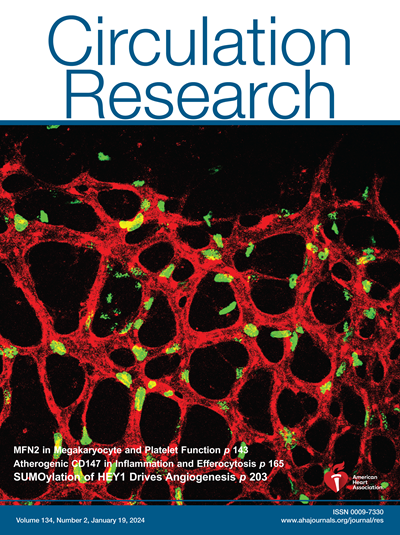Cardiomyocyte GC1 Mediates Estrogenic Angiogenesis in Right Heart Remodeling.
IF 16.2
1区 医学
Q1 CARDIAC & CARDIOVASCULAR SYSTEMS
引用次数: 0
Abstract
BACKGROUND Right ventricular (RV) dysfunction increases mortality in heart failure and pulmonary hypertension. However, women demonstrate better RV function and survival than men. This difference is attributed to estrogen, though mechanistic details remain unclear. Given estrogen's stimulation of NO production, we investigated whether and how cardiomyocyte NO-sensitive soluble GC1 (guanylyl cyclase) mediates female-specific, adaptive RV pressure-overload remodeling. METHODS Adult male and female mice with cardiomyocyte-specific GC1 deficiency (cardiomyocyte-specific knockout) and littermate controls underwent pulmonary artery banding (PAB) or thoracotomy (Sham). At 6-week postsurgery, RV function was assessed via echocardiography, pressure-volume loops, and treadmill testing. RV function, histopathology, and transcript profiles were compared across sex, genotype, and surgical group. Single-nucleus RNA sequencing of RV tissue was performed to identify putative cardiomyocyte GC1-mediated cell-cell communication in adaptive RV pressure-overload remodeling. Endothelial coculture assays with controls versus cardiomyocyte-specific knockout cardiomyocytes evaluated estrogen and cardiomyocyte GC1-dependence of the identified intercellular signaling. RESULTS Female controls PAB adapted RV contractility to overcome RV pressure-overload, thereby preserving RV-PA coupling. In contrast, female cardiomyocyte-specific knockout, ovariectomized female controls, and male PAB developed severe RV dysfunction with RV-PA uncoupling. These groups with maladapted RVs had marked cardiomyocyte hypertrophy, interstitial fibrosis, and capillary rarefaction; female control PAB had minimal changes. Among histological features, the capillary-to-cardiomyocyte ratio showed the strongest correlation with RV function. Ratios were similar between female control PAB and Sham, but abnormally low in all other PAB. Single-nucleus RNA sequence and coculture analyses revealed that cardiomyocyte GC1 is central to Vegf (vascular endothelial growth factor)-Vegfr proangiogenic signaling from cardiomyocytes to endothelial cells in the adaptively remodeled, pressure-overloaded RV. CONCLUSIONS We identified a novel estrogen- and cardiomyocyte GC1-dependent pathway that mitigates capillary rarefaction, maintaining normal capillary-to-cardiomyocyte ratio and preserving RV-PA coupling under RV pressure-overload. This proangiogenic, estrogen- and cardiomyocyte GC1-dependent mechanism contributes to sex-specific differences in RV remodeling and may inform the development of targeted therapies for RV dysfunction.心肌细胞GC1介导右心重构中的雌激素血管生成。
背景:右心室功能障碍增加心力衰竭和肺动脉高压的死亡率。然而,女性表现出比男性更好的右心室功能和存活率。这种差异归因于雌激素,尽管机制细节尚不清楚。考虑到雌激素刺激NO的产生,我们研究了心肌细胞NO敏感的可溶性GC1(冠酰环化酶)是否以及如何介导女性特异性的适应性RV压力过载重塑。方法对心肌细胞特异性GC1缺失(心肌细胞特异性敲除)的成年雄性和雌性小鼠和对照组进行肺动脉束带(PAB)或开胸手术(Sham)。术后6周,通过超声心动图、压力-容量循环和跑步机测试评估右心室功能。在性别、基因型和手术组之间比较RV功能、组织病理学和转录谱。研究人员对右心室组织进行了单核RNA测序,以鉴定心肌细胞gc1介导的细胞间通讯在适应性右心室压力过载重塑中的作用。内皮共培养试验,对照心肌细胞特异性敲除心肌细胞,评估雌激素和心肌细胞gc1对细胞间信号的依赖性。结果女性控制组的PAB调节了RV的收缩性,克服了RV的压力过载,从而保持了RV- pa的耦合。相比之下,女性心肌细胞特异性敲除、卵巢切除的女性对照组和男性PAB出现了严重的RV功能障碍,并伴有RV- pa解耦。这些RVs不适应组心肌细胞肥大、间质纤维化和毛细血管稀疏;女性控制组PAB变化最小。在组织学特征中,毛细血管与心肌细胞的比值与心室功能的相关性最强。女性对照PAB和Sham之间的比率相似,但在所有其他PAB中异常低。单核RNA序列和共培养分析显示,在适应性重构、压力过载的RV中,心肌细胞GC1对从心肌细胞到内皮细胞的Vegf(血管内皮生长因子)-Vegfr促血管生成信号传导至关重要。我们发现了一种新的雌激素和心肌细胞gc1依赖途径,可以减轻毛细血管稀薄,维持正常的毛细血管与心肌细胞的比例,并在心室压力过载的情况下保持心室- pa偶联。这种促血管生成、雌激素和心肌细胞gc1依赖的机制有助于RV重塑的性别特异性差异,并可能为RV功能障碍靶向治疗的发展提供信息。
本文章由计算机程序翻译,如有差异,请以英文原文为准。
求助全文
约1分钟内获得全文
求助全文
来源期刊

Circulation research
医学-外周血管病
CiteScore
29.60
自引率
2.00%
发文量
535
审稿时长
3-6 weeks
期刊介绍:
Circulation Research is a peer-reviewed journal that serves as a forum for the highest quality research in basic cardiovascular biology. The journal publishes studies that utilize state-of-the-art approaches to investigate mechanisms of human disease, as well as translational and clinical research that provide fundamental insights into the basis of disease and the mechanism of therapies.
Circulation Research has a broad audience that includes clinical and academic cardiologists, basic cardiovascular scientists, physiologists, cellular and molecular biologists, and cardiovascular pharmacologists. The journal aims to advance the understanding of cardiovascular biology and disease by disseminating cutting-edge research to these diverse communities.
In terms of indexing, Circulation Research is included in several prominent scientific databases, including BIOSIS, CAB Abstracts, Chemical Abstracts, Current Contents, EMBASE, and MEDLINE. This ensures that the journal's articles are easily discoverable and accessible to researchers in the field.
Overall, Circulation Research is a reputable publication that attracts high-quality research and provides a platform for the dissemination of important findings in basic cardiovascular biology and its translational and clinical applications.
 求助内容:
求助内容: 应助结果提醒方式:
应助结果提醒方式:


